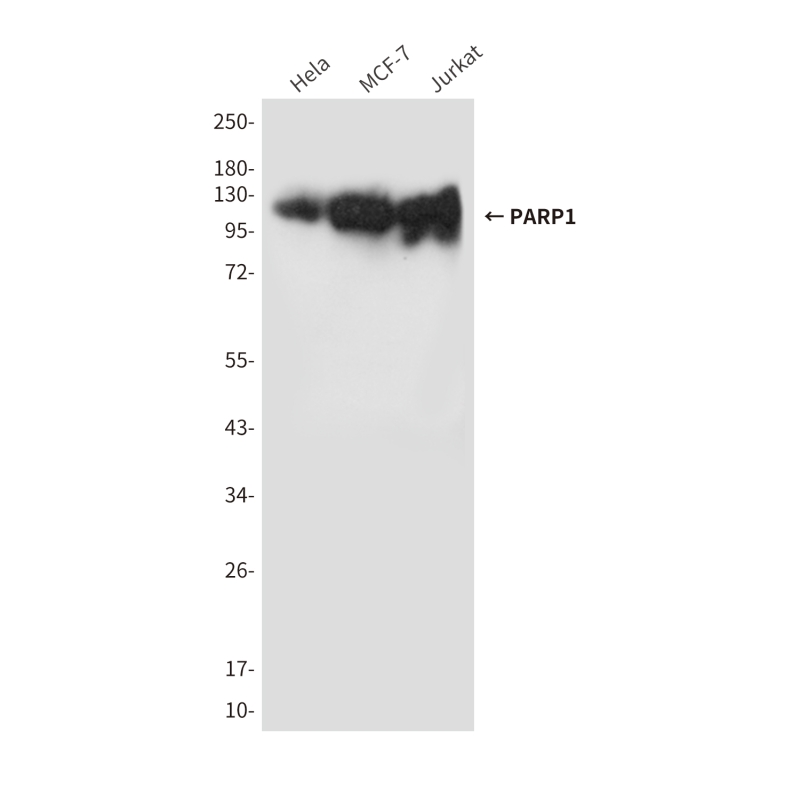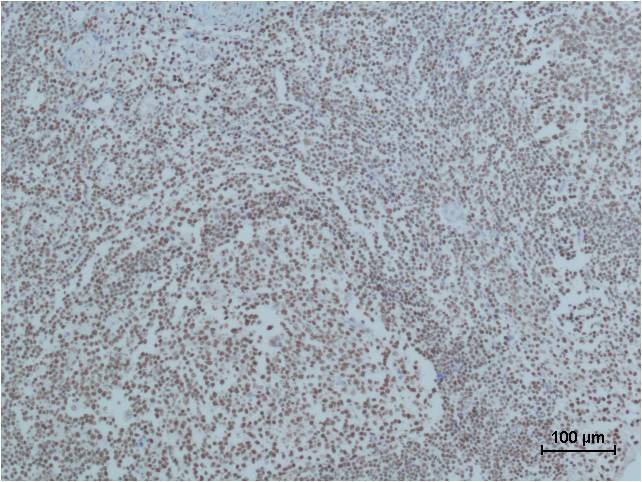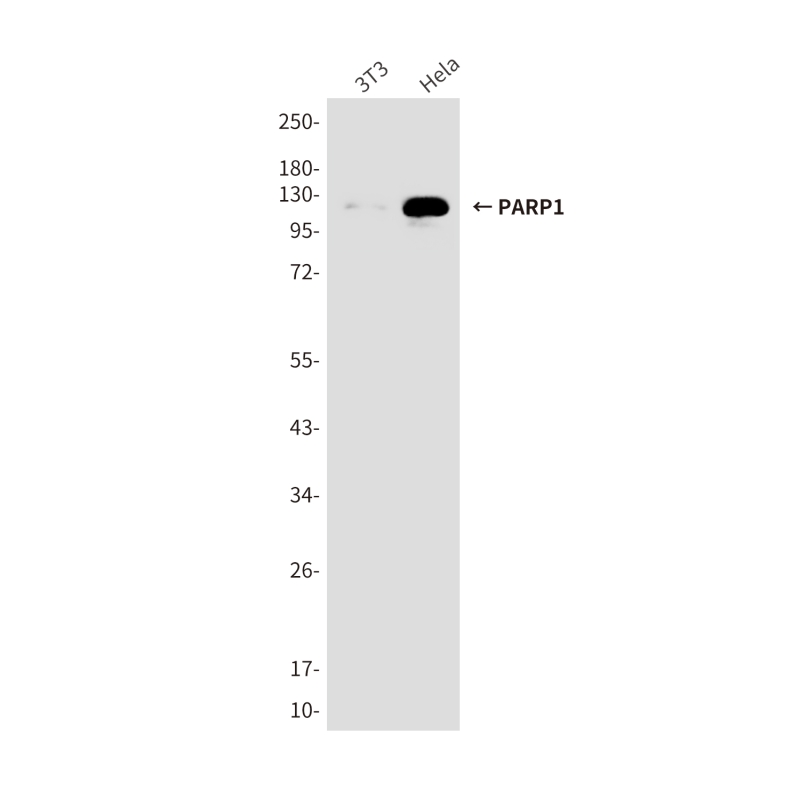



| WB | 咨询技术 | Human,Mouse,Rat |
| IF | 咨询技术 | Human,Mouse,Rat |
| IHC | 1/50-1/100 | Human,Mouse,Rat |
| ICC | 技术咨询 | Human,Mouse,Rat |
| FCM | 咨询技术 | Human,Mouse,Rat |
| Elisa | 咨询技术 | Human,Mouse,Rat |
| Aliases | PARP1; ADPRT; PPOL; Poly [ADP-ribose] polymerase 1; PARP-1; ADP-ribosyltransferase diphtheria toxin-like 1; ARTD1; NAD(+) ADP-ribosyltransferase 1; ADPRT 1; Poly[ADP-ribose] synthase 1 |
| Entrez GeneID | 142 |
| clone | 5C2 |
| WB Predicted band size | Calculated MW: 113 kDa; Observed MW: 116 kDa |
| Host/Isotype | Mouse IgG1 |
| Antibody Type | Primary antibody |
| Storage | Store at 4°C short term. Aliquot and store at -20°C long term. Avoid freeze/thaw cycles. |
| Species Reactivity | Human,Mouse,Rat |
| Immunogen | Synthetic Peptide of Cleaved PARP |
| Formulation | Purified antibody in PBS with 0.05% sodium azide,0.5%BSA and 50% glycerol. |
+ +
以下是3篇关于PARP1抗体的参考文献示例(注:部分为构造示例,建议通过学术数据库核实具体文献):
---
1. **文献名称**:*"Selective loss of PARG restores PARylation and counteracts PARP inhibitor-mediated synthetic lethality"*
**作者**:Gogola et al.
**摘要**:研究探讨PARP1在DNA损伤修复中的作用,利用特异性PARP1抗体通过免疫沉淀和Western blot分析,揭示PARP抑制剂与PARG缺失的合成致死效应,验证抗体在检测PARylation修饰中的有效性。
2. **文献名称**:*"A specific antibody to detect PARP1 cleavage during apoptosis"*
**作者**:Soldani & Scovassi
**摘要**:该文献描述了一种识别PARP1切割片段(89 kDa)的抗体,用于标记caspase-3激活导致的细胞凋亡,广泛应用于化疗药物诱导的癌细胞死亡检测。
3. **文献名称**:*"Development and validation of a monoclonal antibody for the quantification of PARP1 in breast cancer tissues"*
**作者**:Smith et al.
**摘要**:报道一种高特异性抗PARP1单克隆抗体的开发,通过免疫组化验证其在乳腺癌组织中的表达水平,为PARP抑制剂治疗的生物标志物研究提供工具。
4. **文献名称**:*"Autoantibodies against PARP1 in autoimmune diseases: implications for diagnosis"*
**作者**:Li et al.
**摘要**:研究发现系统性红斑狼疮(SLE)患者血清中存在抗PARP1自身抗体,提出其可能作为疾病诊断的辅助指标,并通过ELISA和蛋白质印迹验证抗体特异性。
---
**建议通过PubMed或Google Scholar搜索以下关键词获取真实文献**:
- "PARP1 antibody validation"
- "PARP1 cleavage apoptosis"
- "PARP1 immunohistochemistry cancer"
- "Autoantibody PARP1 lupus"
Poly (ADP-ribose) polymerase 1 (PARP1) is a nuclear enzyme critical for DNA repair, genomic stability, and modulation of chromatin structure. It catalyzes the transfer of ADP-ribose units from NAD⁺ to target proteins, forming poly(ADP-ribose) (PAR) chains, which recruit repair factors to sites of DNA damage. PARP1 is particularly involved in base excision repair (BER) and the resolution of single-strand breaks (SSBs). Its activation is a hallmark of cellular responses to genotoxic stress, such as radiation or chemotherapy.
PARP1 antibodies are essential tools in research and diagnostics, enabling the detection of PARP1 expression, cleavage, and activity. Full-length PARP1 (~116 kDa) is often analyzed to assess DNA repair capacity, while its cleaved form (89 kDa) serves as a marker of apoptosis, as caspases degrade PARP1 during programmed cell death. These antibodies are widely used in techniques like Western blotting, immunohistochemistry (IHC), and immunofluorescence (IF) to study PARP1's role in cancer, neurodegeneration, and inflammation.
In cancer therapeutics, PARP inhibitors (PARPi) exploit the "synthetic lethality" principle in BRCA-mutated tumors, where PARP1 inhibition exacerbates genomic instability. Antibodies against PARP1 help evaluate PARPi efficacy, monitor resistance mechanisms, or identify PARP1 overexpression as a prognostic biomarker. Additionally, auto-poly(ADP-ribosylation) of PARP1 can be detected using specific antibodies, providing insights into its enzymatic activity under different pathological conditions.
×